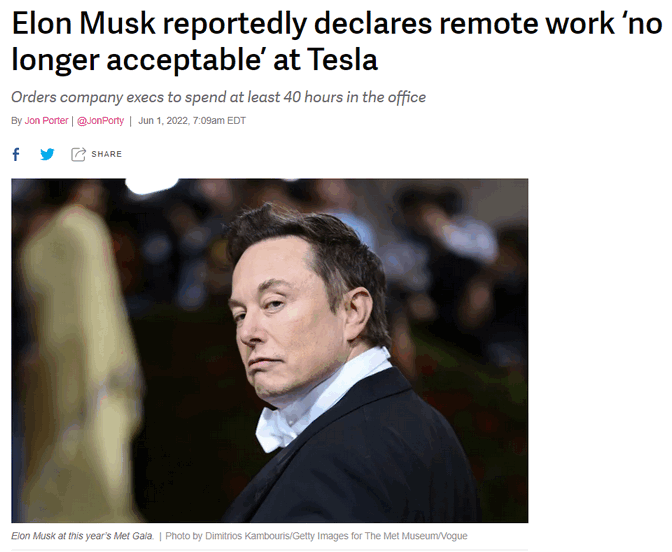Search the Community
Showing results for tags 'wfh'.
-
https://www.channelnewsasia.com/commentary/work-life-balance-covid-19-hybrid-remote-great-resignation-wave-jobs-2682751 Many of us hold on to work-life balance as an ideal, without acknowledging the blood and sweat that make it possible in the first place, or how it’s not always feasible in our circumstances, says business writer Keith Yap. SINGAPORE: Since the COVID-19 pandemic began, working norms, especially in knowledge-intensive industries, have changed forever. Many of us have become skilled practitioners of working from home, attending Zoom Meetings with smart tops and pyjama bottoms, and eating lunches with Netflix instead of co-workers. In light of other trends like employees reconsidering their priorities and quitting their jobs, the narratives surrounding the future of work has percolated into online discourse. From TikTok to Harvard Business Review, the Internet is replete with advice on navigating this brave new world after the pandemic. While narratives about work are varied and fragmented, the motif of workers' burnout remains consistent. As offices in Singapore fling their doors open to welcome back all workers, many are pushing back against burnout in favour of pursuing work-life balance. Many of us visualise a seesaw when thinking about work-life balance, with the ideal of work and life on both ends perfectly level. It’s a zero-sum game and our language reflects any perceived imbalance – work “eats into” our weekends, we worry about "sacrificing" careers if we have kids and take parental leave. The hypothetical employee who’s achieved the coveted work-life balance looks like this: They enjoy autonomy in their professional life. They work a remote job, log in at nine, be ultra productive and go offline at six, commuting to the office only twice a week. They can reject all work communication outside of those hours. The rest of their time is protected for better pursuits, dedicated to dabbling in the guitar, cooking risotto for the family and catching up with pals every week. JOB MOVEMENTS AREN’T ALWAYS LIFESTYLE UPGRADES But a closer look reveals two key problems. First, a rigid conceptualisation of balance assumes such a lifestyle is immediately attainable for everyone, especially more junior employees. The Great Resignation Wave should not conceal the fact that many workers are leveraging the moment to move up in the same industry to get higher pay and more flexible work arrangements. But to make such moves, workers need bargaining power. They do this by spending most of their waking lives for years honing their craft, developing an edge to differentiate themselves in a crowded labour market. If workers at the beginning of their career prioritise flexibility and autonomy, they will end up compromising on picking up and perfecting skills required for career progression. Granted, one can reject the prospect of sprinting up the corporate ladder and trade progression for flexibility. This trade-off is laudable for some but impractical for others. However, current discussions assume job movements are unconditional lifestyle upgrades, without acknowledging the blood and sweat that made them possible. And with the new slate of responsibilities, the exigencies of work might mean compartmentalising work and life becomes even more challenging for all but the most senior roles. COMPANIES CAN’T ALWAYS PROMISE WORK-LIFE BALANCE With the spotlight on employee well-being, companies are embarking on more initiatives like offering mindfulness workshops or meditation apps, even giving employees mental health off days. Workers point out such efforts do not address the root cause of burnout: Exhausting work conditions. More are calling on corporate leaders to re-examine working hours and their expectations of employees. But here lies the second problem: Despite the best efforts of employers, the realities of work often make it difficult for companies to promise work-life balance. Any seasoned worker knows projects often take more time than expected and are prepared to work overtime to meet deadlines. The inconvenient truth is that a company exists for-profit and must outperform competitors. Thus the paradox of work-life balance is two-fold. To provide it indiscriminately, the company risks compromising its mission. To pursue it indiscriminately, the worker risks compromising career progression. EMBRACING WORK-LIFE RHYTHM INSTEAD It might be high time to discard the term “work-life balance” and that mental image of a seesaw. Let’s embrace instead the pursuit of a healthy “work-life rhythm” - a rhythm that moves with need, alternating between periods of hard work and deep rest over time. This can facilitate professional development and organisational growth while alleviating worker burnout. During periods of hard work, the worker is focused on project completion and will expect an intense workload. This could mean working past office hours regularly or even burning the midnight oil on some occasions. In return, companies can guarantee a minimum of work-free hours (such as weekends or mass block leave) so workers can tend to their personal lives. Conversely, professional obligations would be kept to an absolute minimum during periods of deep rest. During a company-wide lull, staff don’t have to worry about lingering work responsibilities, and can take on new hobbies or go on extended vacations. This would mark a divergence from our current practice of leaving workers to manage their leave schedule. Wouldn't we feel a nagging pang of guilt if we scooted over to Bali while our colleagues were working, even when we intuitively know there is not much to do? Conversations on work-life rhythm aren’t yet mainstream, though proponents compare it to seasons. Just as there are seasons for planting, harvesting and resting, we go through life phases where we can give our all to work – whether it’s building a business or designing a product – and where we must dedicate ourselves to family. Beyond the debate whether we should shift towards four-day work weeks, perhaps we should also be talking about 10-month work years. A GREATER APPRECIATION OF LIFE WITH EXTENDED PERIODS OF REST As a healthy work-life rhythm will benefit Singapore greatly, the Government can take the lead, as it has done so by calling for flexible work arrangements to become a permanent feature. The Government can continue actively engaging industry players through incentives and dialogues to shape better work norms. At a national level, such a work-life rhythm creates a society where no one is compelled to work laboriously throughout the year. It could empower more individuals to devote their spare time to work of public importance such as volunteering, political participation and the arts. Other more career-minded ones would improve their skills to be more productive at work. Most importantly, there will be a greater appreciation of life with extended periods of relaxation. We can focus on our family and friends, which goes a long way in countering burnout, cynicism and angst. COVID-19 has forced us to re-imagine the future of work. It might be time to retire the pursuit of the ever-elusive work-life balance. After all, isn't the whole point of a seesaw to enjoy the alternating rhythm of ups and downs instead of always toiling to balance ourselves perfectly?
-
On concerns that flexi-work would result in more jobs offshoring, the Minister of State for Manpower said it was more important to make sure Singapore's workers stay globally competitive in skills and productivity. SINGAPORE: Employers with workers on flexible work arrangements have no basis to cut their pay if their productivity is not affected, Minister of State for Manpower Gan Siow Huang said on Tuesday (May 7). She was responding to a question by Nominated Member of Parliament (NMP) Raj Thomas on how the tripartite guidelines on flexible work arrangement requests would interact with the progressive wage model. The new guidelines, which come into effect on Dec 1, require all employers to have a process for their employees to request flexible work arrangements. Employers must give fair consideration to the requests and respond within two months. They can reject a request on "reasonable business grounds", and must give the employee the reason in writing. The progressive wage model provides a structure for wages to rise along with training and productivity improvements. It covers lower-wage local workers in certain sectors, like cleaning and security. Mr Thomas asked whether an employer would have to reject a worker's request for flexible work arrangements if it meant the worker would work fewer days, bringing his or her gross wage below the prescribed floor of the model. Ms Gan questioned the assumption that pay would be reduced in the first place, saying that employers have to pay competitively to attract and retain good workers. "For workers who are on flexible work arrangements, if their work output, productivity is not affected, actually there is no basis for employers to reduce their pay," she said. Manpower Minister Tan See Leng said that "the spirit of the PWM (progressive wage model) should really lead the entire thinking" behind the implementation of any guidelines. He said the guidelines on flexible work arrangements were based on tripartism and collaboration, and represented a "very nuanced approach". "I think we are moving into newer waters, and I would seek an appeal to the understanding, the support and also the patience of all of us together as one united society, to come together to make this work for the betterment of all of our future generations of workers." Dr Wan Rizal (PAP-Jalan Besar) raised concerns from workers who may want flexible work arrangements but fear if their personal issues, like mental health, are aired in the process, that this could hurt their career progression. Ms Gan reiterated that employers must assess employees' performance and pay them fairly based on work done, and not discriminate based on health conditions that do not affect their performance. After the guidelines were announced, some employers told CNA that as managing remote teams becomes more common, they may rethink hiring local staff and look overseas for recruitment, particularly given the difference in costs. Members of the tripartite working group that drafted the guidelines, co-chaired by Ms Gan, have said that ensuring the local workforce stays competitive will be key as Singapore normalises flexible work arrangements. On Tuesday, Ms Gan reiterated that remote work and outsourcing are already global trends regardless of Singapore's guidelines. "Even if foreigners are not working in Singapore ... they will still be competing with us when working in companies overseas," she said. It was more important for local workers to continually upskill and stay productive to compete for jobs not just in Singapore, but globally, she added. MP Cheryl Chan (PAP-East Coast) then asked whether Singapore would see more offshoring of jobs as a result of the flexible work arrangement guidelines. She also asked whether middle-aged professionals, managers, executives and technicians (PMETs) would be disadvantaged by the guidelines and by the redesign of job roles to accommodate flexible work arrangements. Ms Gan replied that flexible work arrangements were not limited to flexi-place arrangements (like working from home), and did not mean workers will be less productive. She added that businesses were driven by their own bottom lines in assessing talent and costs. "I think we should not pretend that without flexible work arrangements, there'll be less offshoring," she said. "I would also point out that elsewhere, in the US, for example, we are also seeing some tech companies putting out statements that remote work does not work for them. "There seems to be some suggestion that actually, for certain sectors and for certain types of work, physical on-site presence, teamwork, all these are still very key." She said that some companies in Singapore have shared similar feedback, adding: "For those, I think offshoring may not be a natural choice, and certainly would not be affected by these guidelines." Ms Gan said that the focus for middle-aged PMETs is on making sure they have the right skills and on their "career health" to make sure they stay employable. Addressing MPs' questions, she also reiterated that the guidelines do not mandate flexible work arrangements or set hard targets. "For flexible work arrangements to be successful, it must make businesses sustainable for the employers," she said. "It does not make sense to require businesses to offer flexible work arrangements, even when it negatively impacts business and affects employment prospects for Singaporeans."
- 55 replies
-
- wfh
- work from home
- (and 11 more)
-
How I cope with WFH (Working from home) So this is how I am coping with working from home. I am not the most diligent worker you have seen. But my motto is work smart don't work hard. So my job scope is smth like a dialysis machine. . . My boss will have something that needs to improve or need to work on, then I will be the one working on it, making sure that the end products are relatable to the dealers/consumers. And of cuz, MyCarForum is my baby. So everyone here always sees me commenting, laughing, goofing around here. So you can say I am a papa-san in MCF. @RadX & @BabyBlade is still the discipline master and mistress. So, in the morning I wake up in my usual timing, I will pack my bed, do some mediation and light exercise before I wash up myself. Once, I have wash-up, I make myself a cup of oat milk. And because now my office is just like 13 steps away, I just take a slowwww walk back to my "office". I usually start my day with MCF, checking all the past replies and try to find interesting news to share inside MCF. And once I have done it, I will check on my email. replying to all the necessary correspondent. I also try to make my room as bright as possible, so that I am in the zone of working. Usually, my room is like a bat cave. I do not take naps and after a few tasks and replying on MCF, time flies. And it is time for lunch! I took my bicycle and cycle to kopitiam and dabao-ed duck rice. And I will eat at my dining table instead of my room. Just to change the environment abit. While eating, I did watch a bit of the Porsche documentary that @Mockngbrd recommend. Quite a nice documentary. TBH. I haven't finished yet thou. Then after my lunch, I rest a bit, went down and walk my dog and bring her go pee pee. Then when I am back home, I went to shower to freshen myself. Once I am done with the shower, I am back to work! Same old, same old. making sure some of my tasks is done, talking to my colleagues in teams. And usually, during the afternoon my concentration wasn't at my prime. I will "wander" off to read on some other stuff. Mainly is tech/car. (checking how to mod my car or what new stuff xiaomi come out.) Walk to the kitchen and make myself a cup of green tea, and munched on some biscuit. Chatted with my HR abit, as she is making sure we are all working at home. Then go back to work. . . My co-worker have different live thou. 😕 She just NAPPPPPPPP alll the wayyyyy! What do I think of working from home? It is definitely a good initiative at this time, as you minimise on public transport and socializing. However, the person who is working from home, must have some vigilant/discipline, if not end of the day you will be simpson-ing all the way. Here's are some of the things that I find it helpful for myself when I am working from home. Have a designated work area. (Tell yourself, when you are there, you are working.) No working at your bed. I play music while I am working so depends on your style. Separate your dining away from your work area. On aircon/shower if needed. (I tried not to on aircon during the morning, but I BTH. Once I have showered, I on air-con and work) Have a very realistic to-do list (try to strike out as many as possible, can add more list along the way too) Walk around or make urself a coffee if you are not in the zone. (same when you are in the office) So here are some of my takes for working at home. I think is doable, but the end day is still the trust between you and your employer lah. They must trust you, and you must not abuse it also. 🙂 Okay! back to work!
- 789 replies
-
- 21
-

-
.png)
-
- 154 replies
-
- 13
-
.png)
-

-
This is how HardwareZone works from home #HWZWFH source: https://www.hardwarezone.com.sg/blog-how-hardwarezone-works-home-hwzwfh-part-2 My area of solitude Let me start by saying I love my kids. I really do. But preferably, I’d like to love them from my office far away when they’re at home after school. Unfortunately, Covid-19 has changed this with the government issuing Work from Home orders and Home-Based Learning days for students. Working from home, let me say how jealous I am of our associate editor’s setup he showed off last week. The space and equipment on display were enough to make a tech lover like me drool with envy. I don’t need a lot to keep me happy. Give me enough space for a fat man to be comfortable, a nice chair, a big, sharp monitor, and a desktop or laptop that can connect to what I need, when I need it, and I’m satisfied. A man of simple needs and pleasures. In the office I have an office provided desk and chair. I use an office provided PC along with USB-powered keyboard and mouse, and my only indulgence is my 34-inch monitor that allows me to easily view up to three-word documents at a time. At home, I don’t have a proper desk and have had to hijack the dining table. The good thing about it is the real estate I have for my device sprawl. The bad is that it is severely minimal, and this has meant plugs and cables making a mess on the side. My kids do their schoolwork next to me so they have access to easy tech support and a reference library when they get stuck with school work. The mess I try to ignore Comfy chair? Well, I have a chair and it has a padded base and is high enough to sit on and view my screens without having to strain my neck. Any additional storage I need is kept in Ikea bought containers that provide me with ample space for junk. My Ikea storage containers I was initially reduced to using the 13-inch laptop screen on my MacBook Pro but I brought my Acer 32-inch monitor to make it easier for an old man to see the text in small emails and multiple documents. Bigger is always nice The Acer EB321HQU A is a 31.5-inch, 1440p monitor with DVI, HDMI, and DisplayPort inputs. Using an IPS panel with a 60Hz refresh rate and 4ms response time, it comes with a tilting stand, has picture-in-picture and picture-by-picture modes. It is more than enough for my current needs. I can even have a video running quietly in the background without any problem. But having seen the screen real estate curved monitors provide, I’ve decided that a curved monitor is the way forward. My laptop is a late- model 2018 13-inch MacBook Pro bought early 2019. It is powered by a 2.3GHz quad-core 8th generation Intel Core i5 processor and 8GB LPDDR3 RAM. It also has 4 Thunderbolt 3 ports. My 2018 model of MacBook Pro I can’t use a speaker as the sound will distract my wife and kids from what they need to do. I also have the occasional conference call. So rather than speakers, I chose to go with a pair of BoseQC20 earphones. This is an active noise cancelling earphone set. The in-ear wearing style means that users can now block out ambient noise in most everyday scenarios. Furthermore, the earphones also come with a convenient talk-through function. The earphones and all the accessories Finally, I added an external keyboard and mouse. The keyboard is a standard wireless, battery-powered one from Apple. Nothing fancy but it works. It may be small but it gets the job done The mouse is a Logitech MX Anywhere 2. Unfortunately, I wasn’t able to review the new MX Master 3 so I’m still using old tech. Old it may be, but it is still one of the better devices out there. MX Anywhere 2 It comes with Darkfield High Precision laser tracking, which allows for tracking on any surface, including glass that’s at least 4mm in thickness. Logitech Flow allows a mouse to control up to three computers seamlessly, allowing the user to move text, images, and files between these devices. The battery lasts slightly more than two months on a full charge.
- 39 replies
-
- 4
-

-
- hardwarezone
- wfh
-
(and 1 more)
Tagged with:







